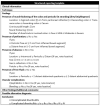Acute Colonic Diverticulitis: CT Findings, Classifications, and a Proposal of a Structured Reporting Template
- PMID: 38132212
- PMCID: PMC10742435
- DOI: 10.3390/diagnostics13243628
Acute Colonic Diverticulitis: CT Findings, Classifications, and a Proposal of a Structured Reporting Template
Abstract
Acute colonic diverticulitis (ACD) is the most common complication of diverticular disease and represents an abdominal emergency. It includes a variety of conditions, extending from localized diverticular inflammation to fecal peritonitis, hence the importance of an accurate diagnosis. Contrast-enhanced computed tomography (CE-CT) plays a pivotal role in the diagnosis due to its high sensitivity, specificity, accuracy, and interobserver agreement. In fact, CE-CT allows alternative diagnoses to be excluded, the inflamed diverticulum to be localized, and complications to be identified. Imaging findings have been reviewed, dividing them into bowel and extra-intestinal wall findings. Moreover, CE-CT allows staging of the disease; the most used classifications of ACD severity are Hinchey's modified and WSES classifications. Differential diagnoses include colon carcinoma, epiploic appendagitis, ischemic colitis, appendicitis, infectious enterocolitis, and inflammatory bowel disease. We propose a structured reporting template to standardize the terminology and improve communication between specialists involved in patient care.
Keywords: abscess; colonic; computed tomography; diverticulitis; fistula; perforation; peritonitis; structured report.
Conflict of interest statement
The authors declare no conflict of interest.
Figures












References
-
- Hong M.K., Skandarajah A.R., Hayes I.P. Diverticulosis, diverticular disease and diverticulitis—Definitions and differences. J. Stomal Ther. Aust. 2015;35:8–10.
Publication types
LinkOut - more resources
Full Text Sources

